South Central Florida Express, Inc.
South Central Florida Express, Incorporated (reporting mark SCXF) (originally known as the South Central Florida Railroad (reporting mark SCFE) and run by the Brandywine Valley Railroad until September 17, 1994) is a short line railroad in southern Florida run by US Sugar Corporation. The line largely runs from Sebring to Fort Pierce via Clewiston and runs around the perimeter of Lake Okeechobee. It serves customers at 26 locations.
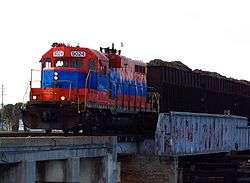 South Central Florida Express crossing Moore Haven Swing Bridge over the Caloosahatchee Canal | ||||||||||||||||||||||||||||||||||||||||||||||||||||||||||||||||||||||||||||||||||||||||||||||||||||||||||||||||||||||||||||||||||||||||||||||||||||||||||||||||||||||||||||||||||||||||||||||||||||||||||||||||||||||||||||||||||||||||||||||
| Overview | ||||||||||||||||||||||||||||||||||||||||||||||||||||||||||||||||||||||||||||||||||||||||||||||||||||||||||||||||||||||||||||||||||||||||||||||||||||||||||||||||||||||||||||||||||||||||||||||||||||||||||||||||||||||||||||||||||||||||||||||
|---|---|---|---|---|---|---|---|---|---|---|---|---|---|---|---|---|---|---|---|---|---|---|---|---|---|---|---|---|---|---|---|---|---|---|---|---|---|---|---|---|---|---|---|---|---|---|---|---|---|---|---|---|---|---|---|---|---|---|---|---|---|---|---|---|---|---|---|---|---|---|---|---|---|---|---|---|---|---|---|---|---|---|---|---|---|---|---|---|---|---|---|---|---|---|---|---|---|---|---|---|---|---|---|---|---|---|---|---|---|---|---|---|---|---|---|---|---|---|---|---|---|---|---|---|---|---|---|---|---|---|---|---|---|---|---|---|---|---|---|---|---|---|---|---|---|---|---|---|---|---|---|---|---|---|---|---|---|---|---|---|---|---|---|---|---|---|---|---|---|---|---|---|---|---|---|---|---|---|---|---|---|---|---|---|---|---|---|---|---|---|---|---|---|---|---|---|---|---|---|---|---|---|---|---|---|---|---|---|---|---|---|---|---|---|---|---|---|---|---|---|---|---|---|---|---|---|---|---|---|---|---|---|---|---|---|---|---|---|
| Headquarters | Clewiston, Florida | |||||||||||||||||||||||||||||||||||||||||||||||||||||||||||||||||||||||||||||||||||||||||||||||||||||||||||||||||||||||||||||||||||||||||||||||||||||||||||||||||||||||||||||||||||||||||||||||||||||||||||||||||||||||||||||||||||||||||||||
| Reporting mark | SCXF | |||||||||||||||||||||||||||||||||||||||||||||||||||||||||||||||||||||||||||||||||||||||||||||||||||||||||||||||||||||||||||||||||||||||||||||||||||||||||||||||||||||||||||||||||||||||||||||||||||||||||||||||||||||||||||||||||||||||||||||
| Locale | south Florida | |||||||||||||||||||||||||||||||||||||||||||||||||||||||||||||||||||||||||||||||||||||||||||||||||||||||||||||||||||||||||||||||||||||||||||||||||||||||||||||||||||||||||||||||||||||||||||||||||||||||||||||||||||||||||||||||||||||||||||||
| Dates of operation | 1994– | |||||||||||||||||||||||||||||||||||||||||||||||||||||||||||||||||||||||||||||||||||||||||||||||||||||||||||||||||||||||||||||||||||||||||||||||||||||||||||||||||||||||||||||||||||||||||||||||||||||||||||||||||||||||||||||||||||||||||||||
| Predecessor | Atlantic Coast Line Railroad CSX Transportation Florida East Coast Railway | |||||||||||||||||||||||||||||||||||||||||||||||||||||||||||||||||||||||||||||||||||||||||||||||||||||||||||||||||||||||||||||||||||||||||||||||||||||||||||||||||||||||||||||||||||||||||||||||||||||||||||||||||||||||||||||||||||||||||||||
| Technical | ||||||||||||||||||||||||||||||||||||||||||||||||||||||||||||||||||||||||||||||||||||||||||||||||||||||||||||||||||||||||||||||||||||||||||||||||||||||||||||||||||||||||||||||||||||||||||||||||||||||||||||||||||||||||||||||||||||||||||||||
| Track gauge | 4 ft 8 1⁄2 in (1,435 mm) standard gauge | |||||||||||||||||||||||||||||||||||||||||||||||||||||||||||||||||||||||||||||||||||||||||||||||||||||||||||||||||||||||||||||||||||||||||||||||||||||||||||||||||||||||||||||||||||||||||||||||||||||||||||||||||||||||||||||||||||||||||||||
| Other | ||||||||||||||||||||||||||||||||||||||||||||||||||||||||||||||||||||||||||||||||||||||||||||||||||||||||||||||||||||||||||||||||||||||||||||||||||||||||||||||||||||||||||||||||||||||||||||||||||||||||||||||||||||||||||||||||||||||||||||||
| Website | www.ussugar.com | |||||||||||||||||||||||||||||||||||||||||||||||||||||||||||||||||||||||||||||||||||||||||||||||||||||||||||||||||||||||||||||||||||||||||||||||||||||||||||||||||||||||||||||||||||||||||||||||||||||||||||||||||||||||||||||||||||||||||||||
| ||||||||||||||||||||||||||||||||||||||||||||||||||||||||||||||||||||||||||||||||||||||||||||||||||||||||||||||||||||||||||||||||||||||||||||||||||||||||||||||||||||||||||||||||||||||||||||||||||||||||||||||||||||||||||||||||||||||||||||||
U.S. Sugar also has its own private trackage known as the U.S. Sugar Railroad (reporting mark USSC) and has branch tracks to sugar fields near Clewiston and Bryant (near Pahokee). USSC has trackage rights of parts of the SCFE main line.[1]
South Central Florida Express began operation in 1994 on tracks previously owned and operated by CSX Transportation and in 1998, operation expanded on to tracks leased from the Florida East Coast Railway.
Operation
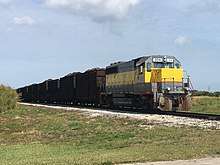
U.S. Sugar is the only sugar company in the continental U.S. to transport sugarcane by rail. The railroad is at its busiest during the main sugar harvest which usually runs from October to March each year.[1]
Sugarcane harvested from fields along the line on the west and south sides of Lake Okeechobee is taken by rail in specially designed rail cars to U.S. Sugar's refinery in Clewiston for processing.[2] SCFE refers to these trains as "Cane Trains", which then take empty cars back out to the fields.
On the east side of the lake, sugarcane is collected the same way and loaded cars are brought to Bryant Yard near Pahokee, where cars are combined on to longer trains before being sent to Clewiston. This movement of trains from Bryant to Clewiston is referred to as the Bryant Turn. During harvest season, Bryant Turn trains can run as often as every four hours.[1][2]
After the sugarcane is refined, by-products such as sugar crystals and molasses are then shipped out from the refinery by rail to interchanges on each end of the line, where they are sent throughout the country. SCFE's western terminus interchanges with CSX Transportation on their Auburndale Subdivision in Sebring, and the eastern terminus in Fort Pierce interchanges with the Florida East Coast Railway. From Fort Pierce, SCFE has haulage rights with FEC to Jacksonville to further interchange with CSX and Norfolk Southern.
Route and History
South Central Florida Express's main line is divided into the East and West Sides. The Miami Canal on the south side of Lake Okeechobee in Lake Harbor is where the two sides officially connect. The milepost numbers on each side are independent on one another and remain as they did under predecessor companies.
West Side
The 87 miles (140 km) of track on the west side of Lake Okeechobee begins in Sebring at a connection with CSX's Auburndale Subdivision just south of Sebring's Amtrak station. A short distance south from Sebring is Desoto City Yard, a small three-track switching yard. CSX has trackage rights into Desoto City Yard where interchange between the two companies takes place.[3]
From Desoto City, the line continues south running mostly parallel to US 27 through Lake Placid and Palmdale. Just south of Palmdale, at a point historically known as Harrisburg, the line turns southeast towards Moore Haven. The line crosses the Caloosahatchee Canal on a small swing bridge in Moore Haven.
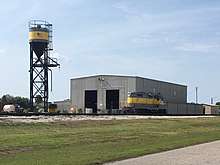
The line continues southeast from Moore Haven winding through sugar fields before reaching Clewiston. Clewiston is the location of U.S. Sugar's refinery which is co-located with SCFE's Clewiston Yard. The yard and refinery are located off the main line on a wye known as Sugar Junction. SCFE's maintenance facility is also located in Clewiston along Owen Avenue.[1]
South of Clewiston, the line winds south and east through more sugar fields before coming to a point known as Keela. At Keela, the line splits with a branch heading south and east to Okeelanta while the main line heads east from Keela to Lake Harbor, where it crosses the Miami Canal and connects with the east side.
The northernmost 42 miles of the west side between Sebring and Harrisburg was built in 1916 by the Atlantic Coast Line Railroad as part of an effort to extend their Haines City Branch south to Immokalee. Harrisburg was named after the Harris track-laying machine used to construct the line. Trackage south of Harrisburg to Immokalee, which went as far south as Everglades City via the former Deep Lake Railroad at one time, was abandoned in the 1980s.[4]
The Atlantic Coast Line built tracks from Harrisburg to Moore Haven in 1918. In 1921, the Moore Haven & Clewiston Railway was built, which extended the Coast Line's tracks to Clewiston. The Coast Line leased the Moore Haven & Clewiston Railway in 1925, and extended it to Lake Harbor in 1929. Even in its early days, the line mostly served U.S. Sugar, who built and operated their own small branch near Clewiston and Lake Okeechobee that connected to the Coast Line. By 1944, the Coast Line completely bought out the Moore Haven & Clewiston Railway.[4]
Through mergers, the Atlantic Coast Line network would become part of CSX Transportation by 1986. CSX operated the line as their Sebring Subdivision along the main line to the sugar fields and Okeelanta Subdivision on the branch to Okeelanta.[5]
The west side was bought from CSX on June 2, 1990, by the Brandywine Valley Railroad, a Lukens Steel Company subsidiary, and sold to U.S. Sugar on September 17, 1994. U.S. Sugar then spun off the railroad into a separate company with its own board of directors to operate independently from the 119 miles (192 km) branch line U.S. Sugar already owned.
East Side
The 71 miles (114 km) of track on the east side of Lake Okeechobee continues the line from Lake Harbor east to South Bay and then north to Belle Glade, Pahokee, and Canal Point.
Located just off the main line on a spur between Pahokee and Canal Point is Bryant Yard. Bryant Yard is used to sort cars and consolidate trains from a number of nearby fields before being sent to Clewiston.[2] Bryant Yard was co-located with the now defunct Bryant Sugar Mill, which closed in 2017.[6]
The line crosses the St. Lucie Canal on a small lift bridge in Port Mayaca. The line then continues to follow the lake a short distance before turning northwest to a point known as Marcy. The line crosses CSX's Auburndale Subdivision at Marcy before continuing northeast directly to Fort Pierce, where it connects to the Florida East Coast Railway.
The east side is leased to South Central Florida Express from the Florida East Coast Railway (FEC referred to this line as their K Branch). It was southernmost segment of the FEC's Kissimmee Valley Line to Lake Okeechobee, which originally branched off the FEC mainline near New Smyrna Beach and ran south through the Kissimmee Valley.[7] It reached Belle Glade by 1923, and was extended to the Miami Canal in Lake Harbor in 1929 to connect with the Atlantic Coast Line. Most of the Kissimmee Valley Line north of Marcy was abandoned in 1947, and the remaining track was connected to the FEC main line by way of a new track from Fort Pierce.[8]
South Central Florida Express began leasing the east side line from the Florida East Coast Railway on March 2, 1998 and now fully operates the line from milepost K 15 (Cana) south, and has trackage rights into FEC's Fort Pierce Yard where the interchange takes place.[1]
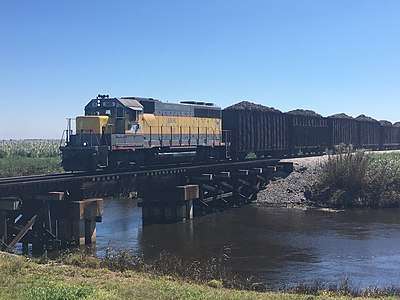 Westbound Bryant Turn train crossing Miami Canal in Lake Harbor
Westbound Bryant Turn train crossing Miami Canal in Lake Harbor Buker Passing Track located at milepost K 67 between South Bay and Lake Harbor. This track is used for storage and for Bryant Turn trains to pass one another
Buker Passing Track located at milepost K 67 between South Bay and Lake Harbor. This track is used for storage and for Bryant Turn trains to pass one another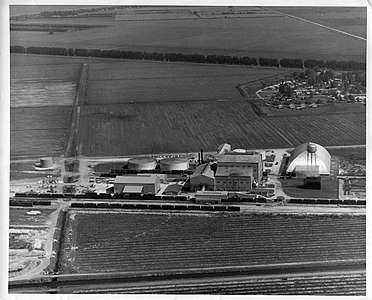 Historic aerial view of Bryant Yard in 1963 with the now defunct Bryant Sugar Mill
Historic aerial view of Bryant Yard in 1963 with the now defunct Bryant Sugar Mill
See also
- List of United States railroads
- List of Florida railroads
References
- "Bote's Florida Sugar Cane Train Chaser's Guide". Bote's Railfan Pages. Retrieved March 19, 2019.
- Harmon, Danny. Sugarcane Train Chase Winter 2018. YouTube. Retrieved April 13, 2019.
- CSX Jacksonville Division Timetable
- Turner, Gregg M. (December 1, 1999). Railroads of Southwest Florida. Images of America. Arcadia Publishing.
- Seaboard Coast Line Railroad Jacksonville Division and Tampa Division Timetable (1977)
- Rangel, Isadora (March 15, 2017). "Glades residents: Sugar mill closing devastated towns". TC Palm. Retrieved January 25, 2020.
- Bramson, Seth (2003). Speedway to Sunshine: The Story of the Florida East Coast Railway. Boston Mills Press.
- Turner, Gregg (2003). A Short History of Florida Railroads. Arcadia Publishing.
External links
| Preceded by St. Lawrence and Atlantic Railroad |
Short Line Railroad of the Year 1999 |
Succeeded by Arkansas Midland Railroad |